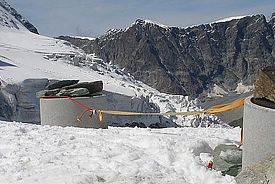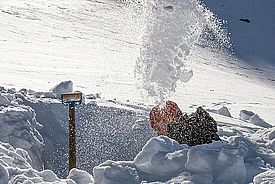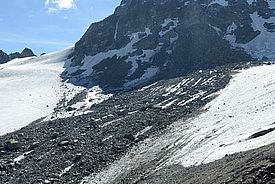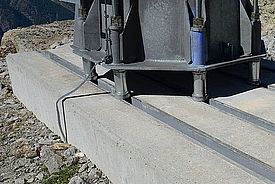
Permafrost ¶
Head: Dr. Marcia Phillips
The SLF Permafrost research group investigates the long-term evolution of permafrost in mountain regions, focusing on ground temperatures, ice-/ water contents, and slope instabilities. Permafrost is an invisible, thermal subsurface phenomenon, which is highly sensitive to changes in climatic conditions. We measure permafrost and its changes using a combination of traditional and cutting-edge technologies such as thermometry, remote sensing and geophysics, and apply various models to investigate the occurring processes. We study the effects of climate, weather, and local surface cover on ground temperature evolution, which we measure in more than 30 boreholes throughout the Swiss Alps. The effects of thawing permafrost, of melting ground ice and of water influxes on deep-seated slope instabilities particularly interest us. The complex processes involved in rock slope deformation and in the kinematics of landforms with high ice contents such as rock glaciers are currently being unraveled by our research team.
We work in close collaboration with scientists and practitioners faced with the challenges of mass movements originating from perennially frozen slopes in high mountain regions, both nationally and internationally. We provide maps and guidelines to support practitioners’ planning processes and decisions. Our data is available via the Swiss Permafrost Monitoring Network PERMOS, which is co-hosted in our group, together with the University of Fribourg. We cover one of the six core topics of the CERC research centre, which is part of SLF.
Brief insight into our research activities ¶
Monitoring ¶
Climate and topography primarily determine where permafrost occurs in the Swiss Alps. A warming atmosphere generally leads to warming permafrost, and eventually to its thawing. We use different long-term measurements to observe the permafrost and its mostly invisible changes in the underground.. >> more
Water in permafrost ¶
We study water in permafrost. This gives us a better understanding of the influence of water and ice on natural hazards. This helps to identify endangered areas in simulations and to warn more reliably of dangers. >> more
Permafrost and natural hazards ¶
When permafrost thaws due to atmospheric warming, natural hazards such as rockfalls and debris flows increase in the high mountains. With our research in the field, with simulations and with experiments in the laboratory, we contribute to increasing the protection of the population against possible dangers. >> more
Building on permafrost ¶
When temperatures rise, the permafrost continues to thaw, losing ice and allowing water to flow through the previously frozen ground. This favours ground movements. As a result, the building substrate no longer bears as well. This endangers existing buildings and requires more elaborate measures for new buildings. >> more
Staff ¶
Permafrost
Groupleader |
|
Scientific staff member |
|
Scientific staff member |
|
PhD student |
|
Scientific staff member |
|
PhD student |
|
Scientific staff member |



